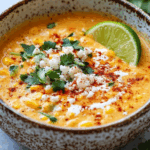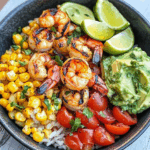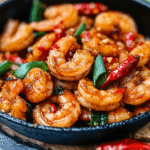A delicious and wholesome banana bread recipe that’s moist, flavorful, and packed with natural sweetness. Perfect for breakfast, snacks, or even dessert, this banana bread uses wholesome ingredients to keep it nutritious without sacrificing taste.
FULL RECIPE
Ingredients
- 3 ripe bananas, mashed
- 2 large eggs
- 1/4 cup honey or maple syrup
- 1/4 cup plain Greek yogurt
- 1/4 cup coconut oil, melted (or any mild oil)
- 1 teaspoon vanilla extract
- 1 1/2 cups whole wheat flour
- 1 teaspoon baking soda
- 1/2 teaspoon baking powder
- 1/2 teaspoon salt
- 1 teaspoon ground cinnamon
- 1/4 cup chopped walnuts or pecans (optional)
Directions
- Preheat the oven to 350°F (175°C). Grease a 9×5-inch loaf pan or line with parchment paper.
- In a large bowl, mix mashed bananas, eggs, honey/maple syrup, Greek yogurt, melted coconut oil, and vanilla extract until smooth.
- In another bowl, whisk together whole wheat flour, baking soda, baking powder, salt, and cinnamon.
- Gradually add the dry ingredients to the wet ingredients, mixing until just combined. Avoid overmixing.
- Fold in chopped nuts if using.
- Pour the batter into the prepared loaf pan and spread evenly.
- Bake for 50-60 minutes or until a toothpick inserted in the center comes out clean.
- Let the bread cool in the pan for 10 minutes, then transfer to a wire rack to cool completely before slicing.
Nutritional Information
- Calories: 180 kcal
- Protein: 4 g
- Carbohydrates: 28 g
- Dietary Fiber: 3 g
- Sugars: 10 g (natural from bananas and honey)
- Fat: 6 g
- Saturated Fat: 2 g
- Sodium: 180 mg
- Potassium: 250 mg
The Nutritional Benefits of Banana Bread
Banana bread is often considered an indulgent treat, but when made with wholesome ingredients like whole wheat flour, ripe bananas, and natural sweeteners, it becomes a nutritious snack or breakfast option. Bananas provide essential vitamins such as vitamin C and B6, along with potassium, which supports heart health and muscle function. Using Greek yogurt adds protein and probiotics, promoting digestive health. Whole wheat flour increases fiber content, aiding in digestion and helping maintain steady blood sugar levels. This combination makes banana bread not only tasty but also beneficial for maintaining energy and overall wellness.
Why Use Ripe Bananas?
Ripe bananas are the key to achieving natural sweetness and moisture in banana bread. As bananas ripen, their starches convert into sugars, making them sweeter and easier to mash. Overripe bananas with brown spots are perfect for baking because they enhance the bread’s flavor and softness without the need for excessive added sugars or fats. Using ripe bananas also reduces food waste by utilizing fruit that might otherwise be discarded. This natural sweetness helps reduce the overall sugar content, making the recipe healthier.
The Role of Whole Wheat Flour
Substituting whole wheat flour for all-purpose flour significantly boosts the nutritional profile of banana bread. Whole wheat flour retains the bran and germ parts of the grain, which contain fiber, vitamins, and minerals. The fiber in whole wheat aids digestion and promotes a feeling of fullness, which can help with appetite control. While whole wheat flour has a denser texture than refined flour, when balanced with moisture-rich ingredients like bananas and yogurt, it produces a moist and flavorful bread that still feels light and tender.
Incorporating Healthy Fats
Using coconut oil or other mild oils in banana bread introduces healthy fats that are essential for brain health and hormone regulation. Unlike butter, oils like coconut oil contain medium-chain triglycerides (MCTs), which may provide quick energy and support metabolism. These fats also help retain moisture, ensuring the bread stays soft for days. Choosing plant-based oils over saturated fats contributes to a heart-healthier recipe without sacrificing texture or flavor.
The Importance of Natural Sweeteners
Honey or maple syrup replaces refined sugars in this banana bread recipe, adding both sweetness and trace nutrients. Natural sweeteners contain antioxidants and minerals that refined sugars lack. Though still sources of sugar, honey and maple syrup have a lower glycemic index compared to white sugar, which means they raise blood sugar levels more gradually. This helps prevent energy crashes and supports better blood sugar management when consumed in moderation.
Adding Greek Yogurt for Protein and Moisture
Greek yogurt is an excellent ingredient in banana bread because it adds protein and moisture without excess fat. Protein helps build and repair body tissues and supports muscle health, making the bread more satisfying and nutritious. The yogurt also contributes a subtle tanginess that balances the sweetness of the bananas and sweetener, enhancing overall flavor complexity. Additionally, probiotics found in yogurt promote gut health and immune function.
How Spices Enhance Flavor
Cinnamon and other warm spices like nutmeg or allspice are often added to banana bread for their flavor and health benefits. Cinnamon, for example, not only adds a comforting warmth but also has anti-inflammatory and blood sugar-regulating properties. Spices can elevate the taste without adding calories or sugar, allowing for a richer, more complex flavor profile. They also complement the natural sweetness of the bananas and honey, making each bite deliciously aromatic.
Optional Nuts for Texture and Nutrition
Adding chopped walnuts or pecans to banana bread introduces a crunchy texture contrast while boosting its nutritional value. Nuts are rich in heart-healthy fats, protein, fiber, vitamins, and minerals like magnesium. Their healthy fats can help improve cholesterol levels and support brain function. Including nuts also adds satiety, helping the bread serve as a more filling snack. Toasting nuts before adding them to the batter can enhance their flavor and aroma even more.
Tips for Baking Perfect Banana Bread
Achieving moist, tender banana bread requires careful attention to mixing and baking times. Overmixing the batter can develop gluten and make the bread tough, so it’s best to mix just until the ingredients come together. Baking at the right temperature ensures even cooking without drying out the loaf. Using a toothpick to check doneness is a foolproof method to prevent underbaking or overbaking. Letting the bread cool completely before slicing helps it set and keeps the texture ideal.
Storing and Serving Suggestions
Banana bread keeps well stored in an airtight container at room temperature for several days or refrigerated for up to a week. Wrapping slices individually and freezing them is a great way to extend shelf life and enjoy fresh-tasting bread whenever you want. This banana bread is delicious served plain, toasted with a bit of butter or nut butter, or paired with a cup of coffee or tea. It’s also versatile enough to be transformed into French toast or used as a base for bread pudding.
Suitable for Various Diets
This banana bread recipe fits well into many dietary preferences. It’s naturally free from refined sugar and can be made dairy-free by using plant-based yogurt and oil instead of butter. The use of whole wheat flour increases fiber, making it friendly for those managing blood sugar levels. The recipe can also be adapted to be gluten-free by substituting whole wheat flour with a gluten-free flour blend, making it accessible for people with gluten sensitivities.
Why Banana Bread is a Great Snack for All Ages
Banana bread is a universally loved snack suitable for kids, adults, and seniors alike. Its soft texture makes it easy to chew and digest, while its natural sweetness appeals to all palates. The balance of carbohydrates, protein, and healthy fats provides sustained energy, making it an ideal snack between meals or a quick breakfast on the go. Parents often choose banana bread as a healthier treat alternative to commercial snacks loaded with artificial ingredients.
Environmental and Cost Benefits
Making banana bread at home is an excellent way to reduce food waste by using overripe bananas that might otherwise be discarded. It also tends to be more economical than buying pre-packaged baked goods, especially when using pantry staples. Homemade banana bread allows control over ingredient quality, avoiding preservatives and artificial additives commonly found in store-bought versions. This simple recipe can be a budget-friendly, sustainable addition to your regular meal plan.
Conclusion
Healthy and tasty banana bread is more than just a comforting baked good; it’s a nutritious, versatile recipe that fits many lifestyles and dietary needs. By using wholesome ingredients like ripe bananas, whole wheat flour, natural sweeteners, and healthy fats, this banana bread delivers flavor and nourishment in every slice. Its ease of preparation, storage flexibility, and appeal to all ages make it a timeless favorite in kitchens worldwide. Whether enjoyed for breakfast, a snack, or a light dessert, this banana bread recipe offers a delicious way to nourish your body while satisfying your taste buds.






